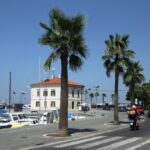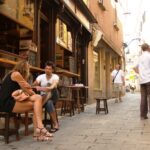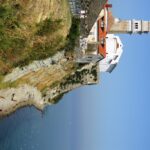We take you on a journey down the unspoiled Slovenian coast into the fragrant orange, lemon and olive gardens of the Debeli Rtič, exploring Koper, teeming with rich culture and colourful history, through the tiny Mediterranean town of Izola, and over to the captivating peninsula of Portorož and Piran, defined by its beautiful spectrum of blue – the ocean, green – the fertile vegetation, and white – for the salt which has historically brought wealth and growth to the region.
Perhaps the best thing about this fairytale cape jutting just ahead of the Italian border, is that it’s small – meaning that with a long weekend to spare, you can experience a sample of deeply rooted traditions, city glamour and uncharted adventure all in the space of a few days.
Hostels in Slovenia
Begin at Debeli Rtič and Ankaran for undisturbed swims and natural paradise
Stay at Ankaran – YH Debeli Rtič
Famous for its health resort, the upper cape of Debeli Rtič (try pronouncing that!) is closely protected, and as a result, you can swim here and walk around freely. Walking around is made all the more idyllic by the flourishing natural park here, where you can wend your way around fragrant trees bearing olives and chestnuts, lemons, tangerines, and walnuts, with banana plants, pomegranates and berry bushes to offer a fruit salad feast for your senses. Inhale the unbeatable fresh scent of sea air floating off the warm waters, and you’ve found paradise.
Go sight seeing in historical Ankaran, originally settled by Romans; see the archaic outpost at Srmin hill, and experience the wine culture which boosted the agricultural life of the area.
Visit Koper – deeply embedded in history, culture and tradition
Stay at YH Histria Koper
Koper has a colourful history: the town dates all the way back to the Bronze Age, and it was then ruled by the Romans, the Byzantine Empire and the Franks, until it was taken over by the Republic of Venice. The Venetians ruled over this territory for a total of five centuries, and have left an indelible mark on Koper’s architecture. When the Venetians lost their grip on the city, the Slovenian Istria became a part of Napoleon’s Illyrian Provinces, later passing into the hands of Austria, Italy and Yugoslavia. Having been called many names including ‘Goat Island’ and ‘Head of Istria’, a walk through this vibrant Mediterranean city’s streets and squares will bring you closer to its exciting history.
Discover the unforgettable romantic character of Izola
Stay at Izola – Hostel Alieti
With centuries-old traditions of fishing and wine making, this Mediterranean town is right on the south-western coast on the Gulf of Trieste. The people here are a real highlight – the tangible warm welcome of locals complements the warm climate. Explore clustered streets, each building painted with a different shade of pastel, sample seafood and wine like you’ve never tasted before, roam around multiple museums and galleries to learn about Istrian arts and crafts, and scale the surrounding hills on foot, on horseback or by bike.
Recuperate around healthy haven Portorož and see the unique salt-pans of Piran
Stay at Potoroz
Portorož has long been lauded for its health benefits: monks of St. Laurence treated local patients with salty seawater, and the curative effects have become known all over the world. Now, there are various ways to boost your wellness and make the most of this haven for relaxation – take a dip in the sea, head out on a boat trip, enjoy thermal water swimming pools or make use of the many health and recreational facilities in the area.
Salt making is an economic activity which has survived for thousands of years on the shores of the Adriatic sea, and although the coastline is dotted with salt works, the most important were found in Piran – now only a small patch in Strunjan. The traditional manual process for panning salt here is unique, and visiting the salt ponds provides an enriching insight into the cultural identity of Mediterranean Slovenia. Luckily, our hostel is located on a hill between Piran and Portorož, with perfect views of this fascinating and unique activity.
Photo credit: Anja Zepic

























